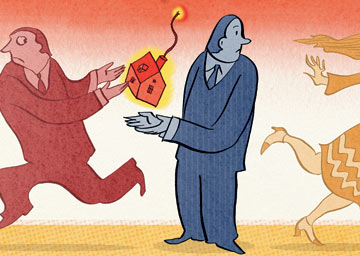|
By Walter Sorochan, Emeritus Professor San Diego State University Posted 2008; Updated November 14, 2021. Who are these two kids? Why are Fannie Mae and Freddie Mac in trouble? The government, and both lenders, are deceiving the public by putting on the wrong spin as the reasons for these lender troubles. Here are a few of their reasons: They are insolvent! They are adequately capitalized! They have been too lax in giving out loans! They were mismanaged! It is price inflation! But the real answer is in swaps. Yes, the lenders are packaging the loans they made into a swap basket and selling these baskets as paper debts to whoever will buy them. This is how Fannie and Freddie make money. Kopecki: freddie fannie insolvency 2008
The best solution is to get rid of the Credit Default Swap or CDS system. It is amazing how the government and politicians cover up the swaps fiasco. They are either ignorant and uninformed of what swaps is and how it works or they are encouraging the use of swaps. The senate and congressional hearings seldom mention swaps or CDS in explaining the current economic problems. It is time to call a spade a spade and face the truth about swaps. It is the biggest scam that has been perpetrated on the world! Who are Fanny Mae and Freddie Mac? Fannie Mae [ the nickname of the Federal National Mortgage Association ] was created by Congress in 1938 to help promote home buying to Americans; Freddie Mac was created in 1970 to expand the secondary market for mortgages. Together, the two own or guarantee approximately $5 trillion of $12 trillion mortgages – slightly less than 50% of all outstanding mortgages in the U.S.. Over the past 12 months they have lost a combined $11 billion, taking America's housing market to the brink of implosion. Fannie Mae's role was to buy up mortgages and sell them on to investors, providing stability and liquidity for home loan firms. As a result, the secondary mortgage market was created. Within the secondary market, companies like Fannie Mae are able to borrow money from foreign and domestic investors at low interest rates because of the financial support that they receive from the US Government. Fannie Mae makes a profit from the difference between the interest rates homeowners pay and foreign lenders charge. Until 1968, Fannie Mae had a monopoly over the secondary mortgage market. But due to fiscal pressures created by the Vietnam War, President Lyndon B Johnson privatized the lender in order to remove it from the accounts. It then became know as a Government Sponsored Enterprise (GSE). The Federal Home Loan Mortgage Corporation, known as Freddie Mac, also a GSE, was set up in 1970 to provide competition to Fannie Mae. Providing reliable returns to shareholders, Fannie and Freddie dominated the secondary mortgage market from 1970, growing to the point where their combined assets were 45 per cent larger than those of the United States' biggest bank Citigroup which has $2.2 trillion under management. On its website Fannie Mae boasts that it has helped "55 million families achieve the American Dream" of home ownership. Since 1980, the evolution of CDS as a hedge derivative instrument for making money has transformed Fannie Mae and Freddie Mac into speculative giants. Speculators gamble with derivatives as a way to make money. The history of Fannie and Freddie has not been without scandal. In 2003, an investigation by the Justice Department and the Securities Exchange Commission into Freddie Mac's accounting practices revealed errors of $4.5 billion. Three top executives were forced to quit as a result of the crisis. This scandal should have been the red light for everyone that both lenders were using deceptive book-keeping and that there would be future problems surfacing. Instead everyone kept quiet and buried their head in the sand! To ensure their survival, the US Government on July 11, 2008, proposed plans to inject billions of dollars of taxpayers’ money into the companies, if necessary, by buying newly issued stock. The government reportedly does not have any rescue plans in the works, should things start to look even uglier. Investors have been concerned for weeks that the two companies would need huge amounts of capital to offset burgeoning losses from delinquent borrowers and rising foreclosures, and to maintain their role in supporting the housing market. Credit Default Swaps are financial instruments based on bonds and loans that are used to speculate on a company's ability to repay debt. They pay the buyer face value in exchange for the underlying securities or the cash equivalent should a borrower fail to adhere to its debt agreements. Refer to Enron and CDS for more information. References: Kopecki Dawn, “ Fannie, Freddie `Insolvent' After Losses, Poole Says (Update1), “ Le Cafe American, July 10, 2008. Kopecki: freddie fannie insolvency 2008
|
 So what is wrong with this? Well, they are selling worthless paper notes. The notes are not regulated, hidden and have no accountability. Basically the system is a Punzi scam like all swaps! It is a time bomb waiting to go off!
So what is wrong with this? Well, they are selling worthless paper notes. The notes are not regulated, hidden and have no accountability. Basically the system is a Punzi scam like all swaps! It is a time bomb waiting to go off!